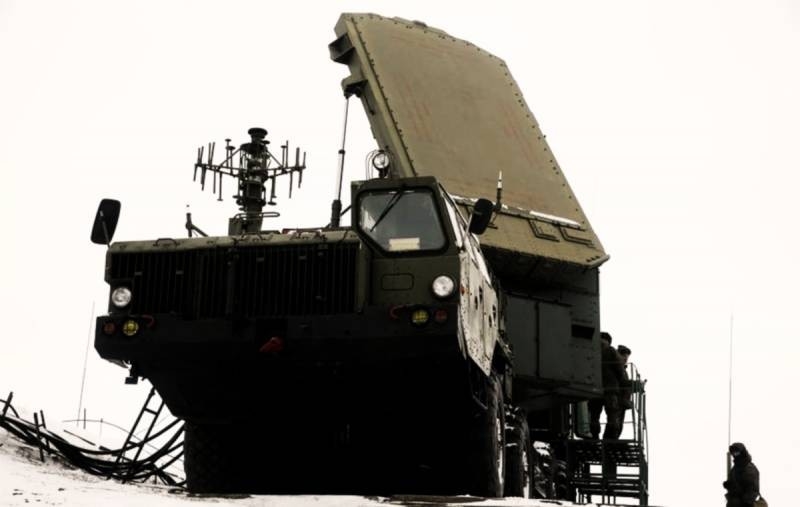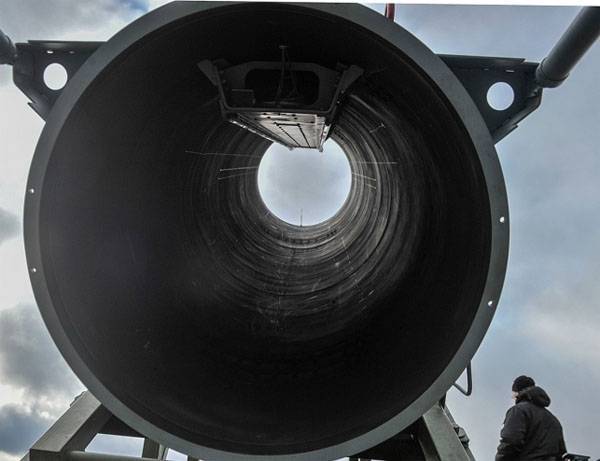An interesting photograph has become the subject of extremely close attention of the regulars of domestic military analytical portals and blogs., photograph taken by Krasnaya Zvezda newspaper during the visit of a delegation of the Serbian Air Defense Forces to the Ashuluk training ground as part of the Slavic Shield 2019 joint exercises of the Anti-Aircraft Missile Forces of the Russian Aerospace Forces and the Serbian Air Defense Forces.

The integration of interceptor missiles of the 9M96E / E2 family into the arsenals of the S-300PM1 anti-aircraft missile systems is the main help in maintaining the combat stability of the anti-aircraft missile regiments of the Russian Aerospace Forces in any theater of military operations
In particular, the photo showed a modernized 5P85SE self-propelled launcher of the S-300PM1 anti-aircraft missile system, equipped not only with standard transport and launch containers for accommodating standard 48N6E long-range anti-aircraft guided missiles (order 150 km), but also a specialized built-in transport and launch module, designed to transport and launch the latest 9M96E medium-range interceptor missiles (about 45 km). The photograph shows, that this 3-cell transport and launch module is located on the attachment points of the standard fourth transport and launch container for 48N6E missiles.
This fact indicates that, that the ammunition load of each self-propelled launcher 5P85SE (or towed 5P85TE) increased exactly to 1,5 fold (three 48N6E anti-aircraft missiles and three 9M96E missiles, respectively), while earlier it was represented by only four 48N6E missiles. Consequently, the total arsenal of one upgraded S-300PM1 anti-aircraft missile battalion will be increased from 48 to 72 anti-aircraft missiles, due to which its combat stability will increase markedly, and the process of "drying out" of ammunition will decrease.
Given the "related" element base (hardware component) electronic "stuffing" of the illumination and guidance radars 30N6E and 92N6E, as well as divisional combat control points 54K6E and 55K6E, easy to come to a conclusion, that the new 9M96E anti-aircraft missile and its longer-range version 9M96E2 will finally be integrated into ammunition as the S-300PM1 air defense system, and in the S-400 Triumph air defense system. Recall, that the architecture of the diamond-anteevsky "four hundred" from the first days of the implementation of R & D provided for equipping the complex with super-maneuverable missiles of the 9M96E / E2 family, but later, in connection with the "childhood diseases" of the active radar seeker (unstable "capture" of targets in the terminal section of the trajectory), the entry into service of these products was characterized by more than 7 years of "slippage". In its turn, this automatically entailed the postponement of the adoption of the latest multi-channel medium and long-range air defense systems S-350 Vityaz, as well as shipborne air defense systems "Redut", unified with the first on ZUR 9M96E / E2.
A relevant question arises: what range of unique operational-tactical and technological advantages will the updated S-300PM1 and S-400 Triumph air defense systems boast in comparison with early modifications of the systems in the case of, if the improved 5P85S launcher announced at the Slavic Shield 2019 exercises leaves the concept demonstrator phase and begins to replenish the regimental sets of "three hundred" and "four hundred"?
While some news journalists, due to low awareness of the architecture of the S-350 Vityaz air defense system, continue to point to the equipping of 9M96E / E2 family interceptor missiles with infrared seekers, in reality, we are talking about a modern active radar seeker of high resolution centimeter (To) or millimeter (Ka) bands based on a slotted antenna array. In contrast to the semi-active radar seeker of anti-aircraft guided missiles 48N6E and 48N6DM, requiring continuous illumination from the multifunctional radar stations 30N6E and 92N6 up to the "meeting" with the goal, active RGSN missiles of the 9M96E family are capable of "capturing" targets with an effective scattering surface of about 1,5 quarter. m (fighter "Typhoon" with weapons on suspension) at a distance of about 55-60 km, after which the need for illumination disappears. Cells of the "AGM-158 JASSM-ER" type (EPR about 0.08-0.1 kV. m) can be "captured" at a distance of 25-27 km. Consequently, S-300PM1 and S-400 air defense systems equipped with this missile will be able to work on targets, "hiding" beyond the radio horizon.

Do not be afraid of robots, bearing gifts
also known, that development experience, serial production and modernization of these types of active radar seeker has only JSC "Moscow Research Institute" Agat ". This means, that the 9M96E / E2 anti-aircraft missile homing head is one of the modifications of the Slanets ARGSN, partially unified with anti-aircraft missiles 9M317M, included in the ammunition of the Buk-M3 air defense system. According to official data, published in the online directory rbase.new-factoria.ru with reference to the Agat Research Institute, this homing head is capable of receiving target designation from a wide range of third-party radar sources, electronic and opto-electronic intelligence (including radar complexes "Shmel" of AWACS A-50U aircraft, airborne radar H011M "Bars-R" Su-30SM fighters, suspended complexes of the Sych family, as well as ship-based and ground-based surveillance radars).
Conclusion: S-300 and S-400 complexes equipped with 9M96E / E2 interceptor missiles will be able to hit even those enemy air attack weapons, which have a low-altitude trajectory throughout the flight and do not “emerge” due to the radio horizon, revealing its location for divisional guidance radars 30N6E or 92N6E. This quality will become a key bonus of the updated "three hundred" in the event of massive missile and air strikes from the enemy..
Another indisputable advantage of the new missiles in comparison with the standard 48N6E and 48N6DM is the presence of a two-tier "gas-dynamic belt" of transverse control engines (DPU), located at the center of mass of the rocket, the benefits of which we have repeatedly listed in our previous reviews. In contrast to the standard developed aerodynamic rudders and the OBT gas jet system, providing a longer ("viscous") SAM turn in the pitch and yaw planes, DPU "belt"., creating an impressive transverse moment of force, provides instantaneous throws of the SAM-interceptor on trajectories with overloads from 60 up to 70G, which allows you to intercept aerodynamic and ballistic objects, maneuvering with overloads of 30-35G and destroy them using the direct hit-to-kill method. Thus, the anti-missile potential of the upgraded S-300PM1 air defense systems can reach the level of the latest S-350 Vityaz anti-missile systems, «Patriot PAC-3 MSE» и SAMP-T.
But there is also an option, according to which the basic ammunition of the S-300PM1 complex can give odds even to the promising Vityaz. We are talking about the speed qualities of the long-range anti-aircraft missile 48N6E. The speed of its flight on the march and the initial sections of the trajectory reaches 5-6.6M, respectively., while the speed of the 9M96E / E2 interceptor missiles is barely approaching the figure of 3.2-4M. It is logical to assume, that the preservation of full-time heavy anti-aircraft missiles with the index 48N6E in the “three hundred” ammunition loadouts will make it possible to intercept enemy high-speed targets that are removed in pursuit at distances of 30-100 km or more.
The presence of this quality can become critical in the case of, if the enemy carried out a massive missile attack on a defended object using several dozen Deep Strike 5-machine aeroballistic missiles or ASN4G high-speed supersonic missiles, and the covering S-300 division did not have time to intercept all the attacking missiles on the opposite course using slower 9M96E anti-missiles. The good old 48N6E successfully compensate for this shortcoming.
Eugene Damantsev











